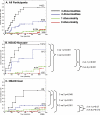NSAIDs modulate CDKN2A, TP53, and DNA content risk for progression to esophageal adenocarcinoma
- PMID: 17326708
- PMCID: PMC1808095
- DOI: 10.1371/journal.pmed.0040067
NSAIDs modulate CDKN2A, TP53, and DNA content risk for progression to esophageal adenocarcinoma
Abstract
Background: Somatic genetic CDKN2A, TP53, and DNA content abnormalities are common in many human cancers and their precursors, including esophageal adenocarcinoma (EA) and Barrett's esophagus (BE), conditions for which aspirin and other nonsteroidal anti-inflammatory drugs (NSAIDs) have been proposed as possible chemopreventive agents; however, little is known about the ability of a biomarker panel to predict progression to cancer nor how NSAID use may modulate progression. We aimed to evaluate somatic genetic abnormalities with NSAIDs as predictors of EA in a prospective cohort study of patients with BE.
Methods and findings: Esophageal biopsies from 243 patients with BE were evaluated at baseline for TP53 and CDKN2A (p16) alterations, tetraploidy, and aneuploidy using sequencing; loss of heterozygosity (LOH); methylation-specific PCR; and flow cytometry. At 10 y, all abnormalities, except CDKN2A mutation and methylation, contributed to EA risk significantly by univariate analysis, ranging from 17p LOH (relative risk [RR] = 10.6; 95% confidence interval [CI] 5.2-21.3, p < 0.001) to 9p LOH (RR = 2.6; 95% CI 1.1-6.0, p = 0.03). A panel of abnormalities including 17p LOH, DNA content tetraploidy and aneuploidy, and 9p LOH was the best predictor of EA (RR = 38.7; 95% CI 10.8-138.5, p < 0.001). Patients with no baseline abnormality had a 12% 10-y cumulative EA incidence, whereas patients with 17p LOH, DNA content abnormalities, and 9p LOH had at least a 79.1% 10-y EA incidence. In patients with zero, one, two, or three baseline panel abnormalities, there was a significant trend toward EA risk reduction among NSAID users compared to nonusers (p = 0.01). The strongest protective effect was seen in participants with multiple genetic abnormalities, with NSAID nonusers having an observed 10-y EA risk of 79%, compared to 30% for NSAID users (p < 0.001).
Conclusions: A combination of 17p LOH, 9p LOH, and DNA content abnormalities provided better EA risk prediction than any single TP53, CDKN2A, or DNA content lesion alone. NSAIDs are associated with reduced EA risk, especially in patients with multiple high-risk molecular abnormalities.
Conflict of interest statement
Figures


Similar articles
-
Clonal expansion and loss of heterozygosity at chromosomes 9p and 17p in premalignant esophageal (Barrett's) tissue.J Natl Cancer Inst. 1999 Dec 15;91(24):2087-95. doi: 10.1093/jnci/91.24.2087. J Natl Cancer Inst. 1999. PMID: 10601379 Free PMC article.
-
Nonsteroidal anti-inflammatory drug use, body mass index, and anthropometry in relation to genetic and flow cytometric abnormalities in Barrett's esophagus.Cancer Epidemiol Biomarkers Prev. 2002 Aug;11(8):745-52. Cancer Epidemiol Biomarkers Prev. 2002. PMID: 12163328
-
Evolution of neoplastic cell lineages in Barrett oesophagus.Nat Genet. 1999 May;22(1):106-9. doi: 10.1038/8816. Nat Genet. 1999. PMID: 10319873 Free PMC article.
-
Early events during neoplastic progression in Barrett's esophagus.Cancer Biomark. 2010;9(1-6):307-24. doi: 10.3233/CBM-2011-0162. Cancer Biomark. 2010. PMID: 22112482 Free PMC article. Review.
-
Meta-analysis of biomarkers predicting risk of malignant progression in Barrett's oesophagus.Br J Surg. 2017 Apr;104(5):493-502. doi: 10.1002/bjs.10484. Br J Surg. 2017. PMID: 28295252 Review.
Cited by
-
The role of tobacco, alcohol, and obesity in neoplastic progression to esophageal adenocarcinoma: a prospective study of Barrett's esophagus.PLoS One. 2013;8(1):e52192. doi: 10.1371/journal.pone.0052192. Epub 2013 Jan 3. PLoS One. 2013. PMID: 23300966 Free PMC article.
-
Development of Advanced Imaging and Molecular Imaging for Barrett's Neoplasia.Diagnostics (Basel). 2022 Oct 8;12(10):2437. doi: 10.3390/diagnostics12102437. Diagnostics (Basel). 2022. PMID: 36292126 Free PMC article. Review.
-
Association between markers of obesity and progression from Barrett's esophagus to esophageal adenocarcinoma.Clin Gastroenterol Hepatol. 2013 Aug;11(8):934-43. doi: 10.1016/j.cgh.2013.02.017. Epub 2013 Mar 1. Clin Gastroenterol Hepatol. 2013. PMID: 23466711 Free PMC article.
-
Correlation of the presence and extent of loss of heterozygosity mutations with histological classifications of Barrett's esophagus.BMC Gastroenterol. 2012 Dec 27;12:181. doi: 10.1186/1471-230X-12-181. BMC Gastroenterol. 2012. PMID: 23270334 Free PMC article.
-
Interactive decision support for esophageal adenocarcinoma screening and surveillance.BMC Gastroenterol. 2019 Jun 27;19(1):109. doi: 10.1186/s12876-019-1022-0. BMC Gastroenterol. 2019. PMID: 31248371 Free PMC article.
References
-
- O'Shaughnessy JA, Kelloff GJ, Gordon GB, Dannenberg AJ, Hong WK, et al. Treatment and prevention of intraepithelial neoplasia: An important target for accelerated new agent development. Clin Cancer Res. 2002;8:314–346. - PubMed
-
- Kelloff GJ, O'Shaughnessy JA, Gordon GB, Hawk ET, Sigman CC. Counterpoint: Because some surrogate end point biomarkers measure the neoplastic process they will have high utility in the development of cancer chemopreventive agents against sporadic cancers. Cancer Epidemiol Biomarkers Prev. 2003;12:593–596. - PubMed
-
- Sullivan Pepe M, Etzioni R, Feng Z, Potter JD, Thompson ML, et al. Phases of biomarker development for early detection of cancer. J Natl Cancer Inst. 2001;93:1054–1061. - PubMed
-
- Dannenberg AJ, Lippman SM, Mann JR, Subbaramaiah K, DuBois RN. Cyclooxygenase-2 and epidermal growth factor receptor: Pharmacologic targets for chemoprevention. J Clin Oncol. 2005;23:254–266. - PubMed
-
- King MC, Marks JH, Mandell JB. Breast and ovarian cancer risks due to inherited mutations in BRCA1 and BRCA2. Science. 2003;302:643–646. - PubMed
Publication types
MeSH terms
Substances
Grants and funding
LinkOut - more resources
Full Text Sources
Other Literature Sources
Medical
Molecular Biology Databases
Research Materials
Miscellaneous

